warning CADILLAC XLR V 2007 1.G Service Manual
[x] Cancel search | Manufacturer: CADILLAC, Model Year: 2007, Model line: XLR V, Model: CADILLAC XLR V 2007 1.GPages: 512, PDF Size: 3.84 MB
Page 338 of 512
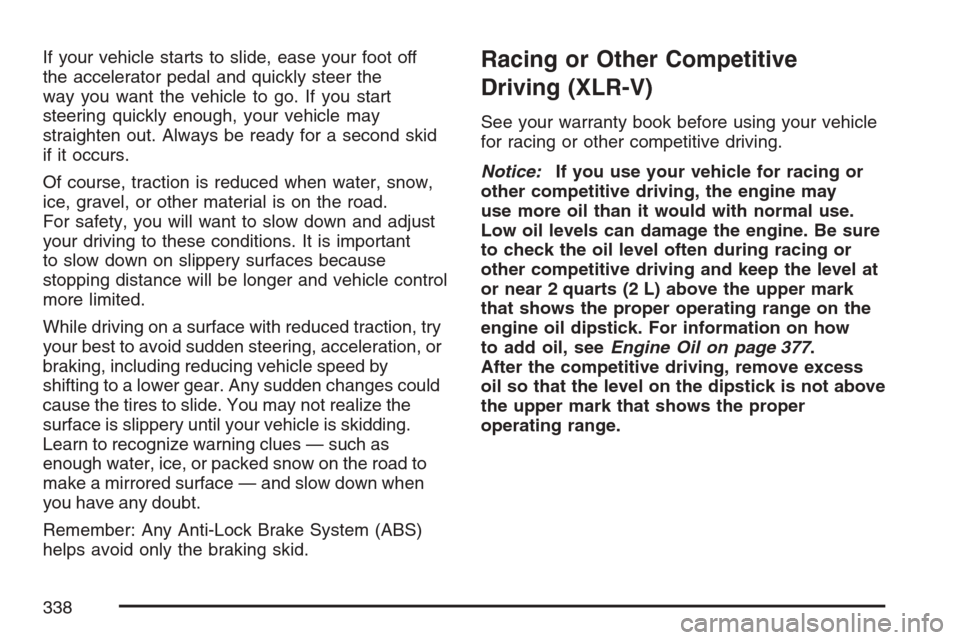
If your vehicle starts to slide, ease your foot off
the accelerator pedal and quickly steer the
way you want the vehicle to go. If you start
steering quickly enough, your vehicle may
straighten out. Always be ready for a second skid
if it occurs.
Of course, traction is reduced when water, snow,
ice, gravel, or other material is on the road.
For safety, you will want to slow down and adjust
your driving to these conditions. It is important
to slow down on slippery surfaces because
stopping distance will be longer and vehicle control
more limited.
While driving on a surface with reduced traction, try
your best to avoid sudden steering, acceleration, or
braking, including reducing vehicle speed by
shifting to a lower gear. Any sudden changes could
cause the tires to slide. You may not realize the
surface is slippery until your vehicle is skidding.
Learn to recognize warning clues — such as
enough water, ice, or packed snow on the road to
make a mirrored surface — and slow down when
you have any doubt.
Remember: Any Anti-Lock Brake System (ABS)
helps avoid only the braking skid.Racing or Other Competitive
Driving (XLR-V)
See your warranty book before using your vehicle
for racing or other competitive driving.
Notice:If you use your vehicle for racing or
other competitive driving, the engine may
use more oil than it would with normal use.
Low oil levels can damage the engine. Be sure
to check the oil level often during racing or
other competitive driving and keep the level at
or near 2 quarts (2 L) above the upper mark
that shows the proper operating range on the
engine oil dipstick. For information on how
to add oil, seeEngine Oil on page 377.
After the competitive driving, remove excess
oil so that the level on the dipstick is not above
the upper mark that shows the proper
operating range.
338
Page 342 of 512

Driving Through Deep Standing Water
Notice:If you drive too quickly through
deep puddles or standing water, water can
come in through your engine’s air intake and
badly damage your engine. Never drive through
water that is slightly lower than the underbody
of your vehicle. If you cannot avoid deep
puddles or standing water, drive through them
very slowly.
Driving Through Flowing Water
{CAUTION:
Flowing or rushing water creates strong
forces. If you try to drive through �owing
water, as you might at a low water
crossing, your vehicle can be carried
away. As little as six inches of �owing
water can carry away a smaller vehicle.
CAUTION: (Continued)
CAUTION: (Continued)
If this happens, you and other vehicle
occupants could drown. Do not ignore
police warning signs, and otherwise be
very cautious about trying to drive
through �owing water.
Some Other Rainy Weather Tips
Besides slowing down, allow some extra
following distance. And be especially careful
when you pass another vehicle. Allow yourself
more clear room ahead, and be prepared to
have your view restricted by road spray.
Have good tires with proper tread depth. See
Tires on page 413.
342
Page 343 of 512

City Driving
One of the biggest problems with city streets is
the amount of traffic on them. You will want
to watch out for what the other drivers are doing
and pay attention to traffic signals.Here are ways to increase your safety in city
driving:
Know the best way to get to where you are
going. Get a city map and plan your trip
into an unknown part of the city just as you
would for a cross-country trip.
Try to use the freeways that rim and crisscross
most large cities. You will save time and
energy. SeeFreeway Driving on page 344.
Treat a green light as a warning signal. A
traffic light is there because the corner is
busy enough to need it. When a light turns
green, and just before you start to move,
check both ways for vehicles that have not
cleared the intersection or may be running the
red light.
343
Page 349 of 512

Winter Driving
Here are some tips for winter driving:
Have your vehicle in good shape for winter.
You may want to put winter emergency
supplies in your vehicle.
Also seeTires on page 413.Include an ice scraper, a small brush or broom, a
supply of windshield washer �uid, a rag, some
winter outer clothing, a small shovel, a �ashlight, a
red cloth, and a couple of re�ective warning
triangles. And, if you will be driving under severe
conditions, include a small bag of sand, a
piece of old carpet, or a couple of burlap bags to
help provide traction. Be sure you properly
secure these items in your vehicle.
349
Page 361 of 512
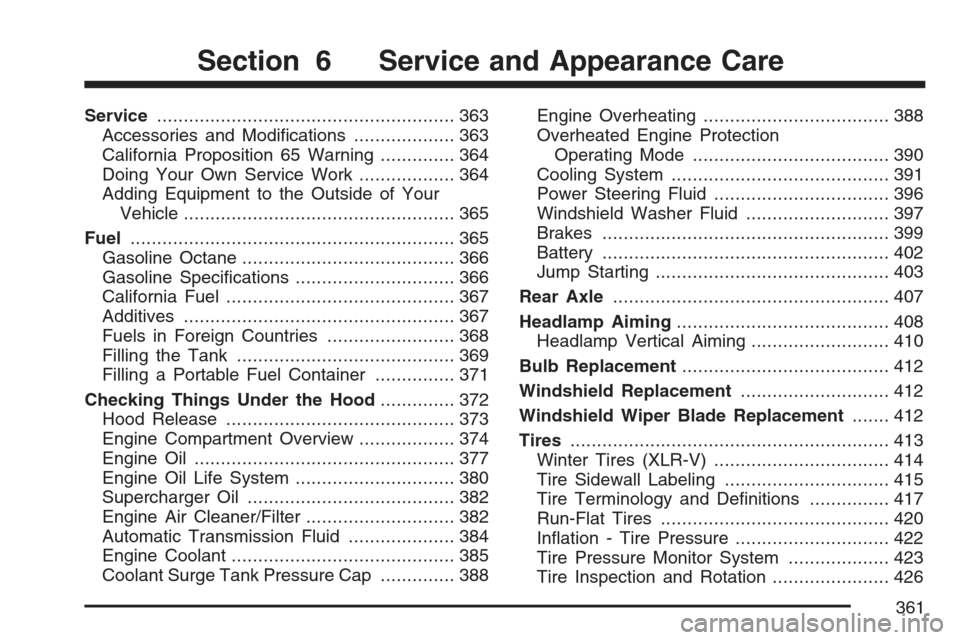
Service........................................................ 363
Accessories and Modi�cations................... 363
California Proposition 65 Warning.............. 364
Doing Your Own Service Work.................. 364
Adding Equipment to the Outside of Your
Vehicle................................................... 365
Fuel............................................................. 365
Gasoline Octane........................................ 366
Gasoline Speci�cations.............................. 366
California Fuel........................................... 367
Additives................................................... 367
Fuels in Foreign Countries........................ 368
Filling the Tank......................................... 369
Filling a Portable Fuel Container............... 371
Checking Things Under the Hood.............. 372
Hood Release........................................... 373
Engine Compartment Overview.................. 374
Engine Oil................................................. 377
Engine Oil Life System.............................. 380
Supercharger Oil....................................... 382
Engine Air Cleaner/Filter............................ 382
Automatic Transmission Fluid.................... 384
Engine Coolant.......................................... 385
Coolant Surge Tank Pressure Cap.............. 388Engine Overheating................................... 388
Overheated Engine Protection
Operating Mode..................................... 390
Cooling System......................................... 391
Power Steering Fluid ................................. 396
Windshield Washer Fluid........................... 397
Brakes...................................................... 399
Battery...................................................... 402
Jump Starting............................................ 403
Rear Axle.................................................... 407
Headlamp Aiming........................................ 408
Headlamp Vertical Aiming.......................... 410
Bulb Replacement....................................... 412
Windshield Replacement............................ 412
Windshield Wiper Blade Replacement....... 412
Tires............................................................ 413
Winter Tires (XLR-V) ................................. 414
Tire Sidewall Labeling............................... 415
Tire Terminology and De�nitions............... 417
Run-Flat Tires........................................... 420
In�ation - Tire Pressure............................. 422
Tire Pressure Monitor System................... 423
Tire Inspection and Rotation...................... 426
Section 6 Service and Appearance Care
361
Page 364 of 512

California Proposition 65 Warning
Most motor vehicles, including this one, contain
and/or emit chemicals known to the State of
California to cause cancer and birth defects or
other reproductive harm. Engine exhaust,
many parts and systems (including some inside
the vehicle), many �uids, and some component
wear by-products contain and/or emit these
chemicals.
Doing Your Own Service Work
{CAUTION:
You can be injured and your vehicle could
be damaged if you try to do service work
on a vehicle without knowing enough
about it.
Be sure you have sufficient knowledge,
experience, the proper replacement
parts, and tools before you attempt any
vehicle maintenance task.
Be sure to use the proper nuts, bolts,
and other fasteners. English and metric
fasteners can be easily confused. If you
use the wrong fasteners, parts can later
break or fall off. You could be hurt.
If you want to do some of your own service work,
you will want to use the proper service manual.
It tells you much more about how to service your
vehicle than this manual can. To order the
proper service manual, seeService Publications
Ordering Information on page 497.
364
Page 377 of 512
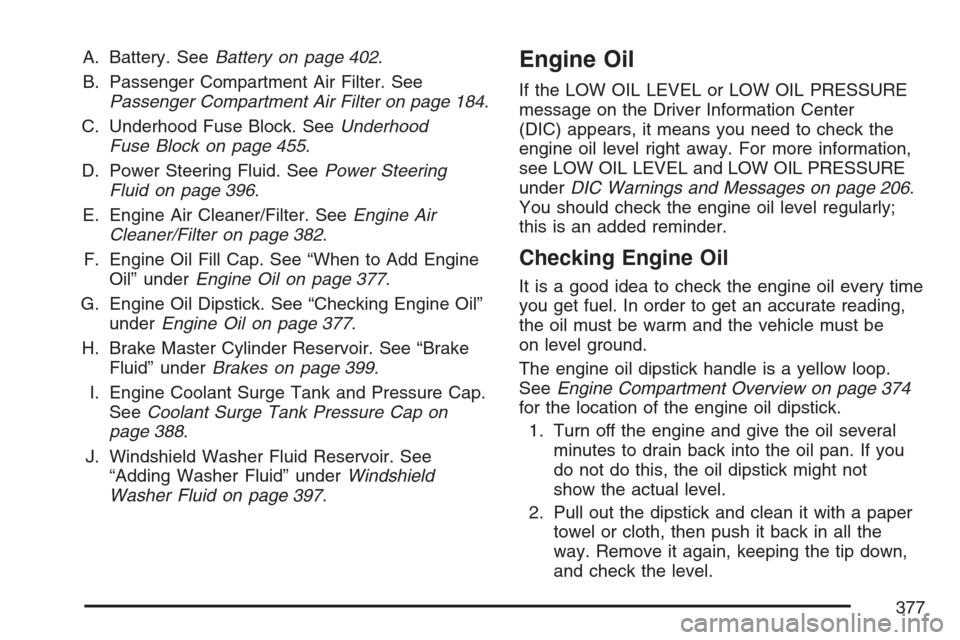
A. Battery. SeeBattery on page 402.
B. Passenger Compartment Air Filter. See
Passenger Compartment Air Filter on page 184.
C. Underhood Fuse Block. SeeUnderhood
Fuse Block on page 455.
D. Power Steering Fluid. SeePower Steering
Fluid on page 396.
E. Engine Air Cleaner/Filter. SeeEngine Air
Cleaner/Filter on page 382.
F. Engine Oil Fill Cap. See “When to Add Engine
Oil” underEngine Oil on page 377.
G. Engine Oil Dipstick. See “Checking Engine Oil”
underEngine Oil on page 377.
H. Brake Master Cylinder Reservoir. See “Brake
Fluid” underBrakes on page 399.
I. Engine Coolant Surge Tank and Pressure Cap.
SeeCoolant Surge Tank Pressure Cap on
page 388.
J. Windshield Washer Fluid Reservoir. See
“Adding Washer Fluid” underWindshield
Washer Fluid on page 397.Engine Oil
If the LOW OIL LEVEL or LOW OIL PRESSURE
message on the Driver Information Center
(DIC) appears, it means you need to check the
engine oil level right away. For more information,
see LOW OIL LEVEL and LOW OIL PRESSURE
underDIC Warnings and Messages on page 206.
You should check the engine oil level regularly;
this is an added reminder.
Checking Engine Oil
It is a good idea to check the engine oil every time
you get fuel. In order to get an accurate reading,
the oil must be warm and the vehicle must be
on level ground.
The engine oil dipstick handle is a yellow loop.
SeeEngine Compartment Overview on page 374
for the location of the engine oil dipstick.
1. Turn off the engine and give the oil several
minutes to drain back into the oil pan. If you
do not do this, the oil dipstick might not
show the actual level.
2. Pull out the dipstick and clean it with a paper
towel or cloth, then push it back in all the
way. Remove it again, keeping the tip down,
and check the level.
377
Page 381 of 512
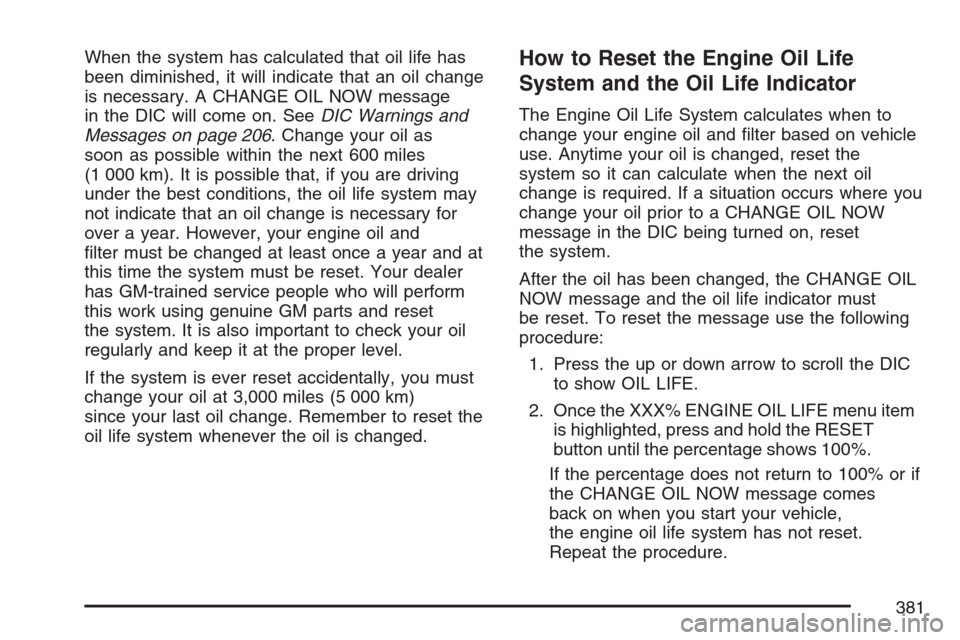
When the system has calculated that oil life has
been diminished, it will indicate that an oil change
is necessary. A CHANGE OIL NOW message
in the DIC will come on. SeeDIC Warnings and
Messages on page 206. Change your oil as
soon as possible within the next 600 miles
(1 000 km). It is possible that, if you are driving
under the best conditions, the oil life system may
not indicate that an oil change is necessary for
over a year. However, your engine oil and
�lter must be changed at least once a year and at
this time the system must be reset. Your dealer
has GM-trained service people who will perform
this work using genuine GM parts and reset
the system. It is also important to check your oil
regularly and keep it at the proper level.
If the system is ever reset accidentally, you must
change your oil at 3,000 miles (5 000 km)
since your last oil change. Remember to reset the
oil life system whenever the oil is changed.How to Reset the Engine Oil Life
System and the Oil Life Indicator
The Engine Oil Life System calculates when to
change your engine oil and �lter based on vehicle
use. Anytime your oil is changed, reset the
system so it can calculate when the next oil
change is required. If a situation occurs where you
change your oil prior to a CHANGE OIL NOW
message in the DIC being turned on, reset
the system.
After the oil has been changed, the CHANGE OIL
NOW message and the oil life indicator must
be reset. To reset the message use the following
procedure:
1. Press the up or down arrow to scroll the DIC
to show OIL LIFE.
2. Once the XXX% ENGINE OIL LIFE menu item
is highlighted, press and hold the RESET
button until the percentage shows 100%.
If the percentage does not return to 100% or if
the CHANGE OIL NOW message comes
back on when you start your vehicle,
the engine oil life system has not reset.
Repeat the procedure.
381
Page 382 of 512
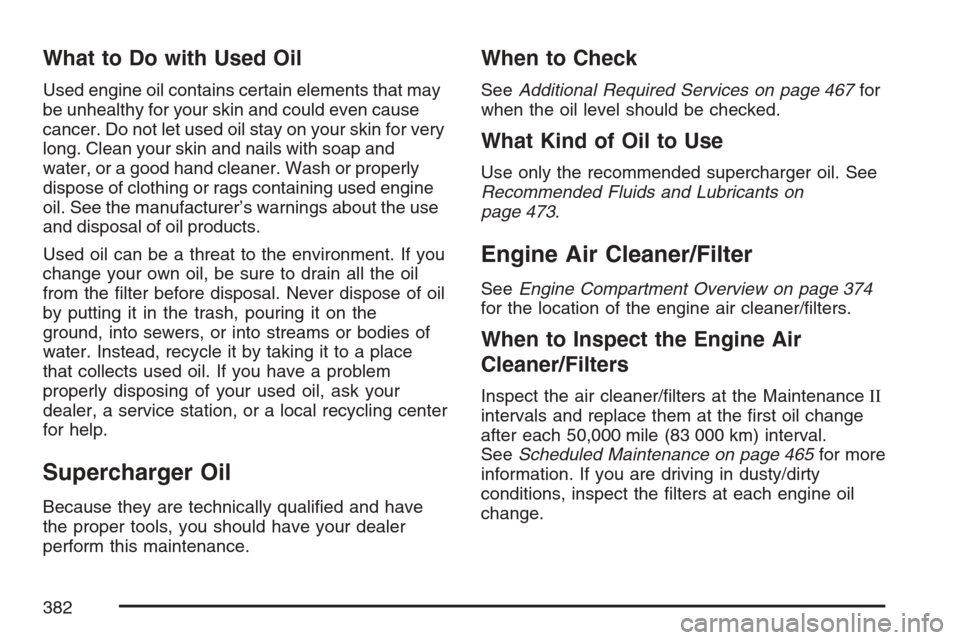
What to Do with Used Oil
Used engine oil contains certain elements that may
be unhealthy for your skin and could even cause
cancer. Do not let used oil stay on your skin for very
long. Clean your skin and nails with soap and
water, or a good hand cleaner. Wash or properly
dispose of clothing or rags containing used engine
oil. See the manufacturer’s warnings about the use
and disposal of oil products.
Used oil can be a threat to the environment. If you
change your own oil, be sure to drain all the oil
from the �lter before disposal. Never dispose of oil
by putting it in the trash, pouring it on the
ground, into sewers, or into streams or bodies of
water. Instead, recycle it by taking it to a place
that collects used oil. If you have a problem
properly disposing of your used oil, ask your
dealer, a service station, or a local recycling center
for help.
Supercharger Oil
Because they are technically quali�ed and have
the proper tools, you should have your dealer
perform this maintenance.
When to Check
SeeAdditional Required Services on page 467for
when the oil level should be checked.
What Kind of Oil to Use
Use only the recommended supercharger oil. See
Recommended Fluids and Lubricants on
page 473.
Engine Air Cleaner/Filter
SeeEngine Compartment Overview on page 374
for the location of the engine air cleaner/�lters.
When to Inspect the Engine Air
Cleaner/Filters
Inspect the air cleaner/�lters at the MaintenanceII
intervals and replace them at the �rst oil change
after each 50,000 mile (83 000 km) interval.
SeeScheduled Maintenance on page 465for more
information. If you are driving in dusty/dirty
conditions, inspect the �lters at each engine oil
change.
382
Page 385 of 512

Change the �uid and �lter at the intervals listed in
Additional Required Services on page 467, and
be sure to use the �uid listed inRecommended
Fluids and Lubricants on page 473.
Engine Coolant
The cooling system in your vehicle is �lled with
DEX-COOL®engine coolant. This coolant is
designed to remain in your vehicle for �ve years or
150,000 miles (240 000 km), whichever occurs
�rst, if you add only DEX-COOL
®extended
life coolant.
The following explains your cooling system and
how to add coolant when it is low. If you have
a problem with engine overheating, seeEngine
Overheating on page 388.A 50/50 mixture of clean, drinkable water and
DEX-COOL
®coolant will:
Giving freezing protection down to−34°F
(−37°C).
Give boiling protection up to 265°F (129°C).
Protect against rust and corrosion.
Help keep the proper engine temperature.
Let the warning lights and gages work as they
should.
Notice:Using coolant other than DEX-COOL
®
may cause premature engine, heater core,
or radiator corrosion. In addition, the engine
coolant may require changing sooner, at
the �rst maintenance service after each
30,000 miles (50 000 km) or 24 months,
whichever occurs �rst. Any repairs would not
be covered by your warranty. Always use
DEX-COOL
®(silicate-free) coolant in your
vehicle.
385